I know that many of you check often and enjoy my blogs. I am going to try to write shorter posts, and do so more often. I have a lot of excuses why I haven't blogged in over a month.
All of my "free time" has been devoted to the construction of the Raptor Facilities. On April 4th, The GE Wildlife Committee helped me get 2 of the 8 indoor enclosures framed out. I am proud to say that a couple of friends helped me "finish" those two enclosures this past weekend. I am estimating that it takes around 30-40 hours to build one enclosure the way that I am doing it. I will get some photos up on the website soon so that you can all see how great that they came out.
As the donations keep coming in, we will keep building. It seems like we are in a never ending state of construction . Combine that with my kids schedules, karate, softball and riding lessons.... I stay out of trouble. I really want to finish these 8 enclosures ASAP so that we will have a species specific cage for virtually any Raptor (Hawk, Owl or Falcon) that may come in.
As soon as the 8 enclosures are done, we are going to have a huge Open House and every donor will be invited to come and see what their (Wildlife) contribution has made. It is beautiful, one of the nicest facilities I've seen.
The second phase of the Raptor Facilities will be a 175 foot addition off of the back of our existing structure. The 8 individual (inside) species aviaries will have doors, so that the birds can be rotated in and out of the huge flight aviary. This facility is desperately needed in our area to prepare raptors for release back into the wild. They must build flying strength to successfully hunt once released or saving them will be a vain effort. Please send your checks to keep construction going and PLEASE stop by and actually see what we are doing. I love giving the 3 minute tour. If I am not at an fundraising event, I am home working at our facility. If you stay longer than 30 minutes I will put you to work.... :)
Michele, Kelly, Gayle and I did two events on April 25th. Michele, Gayle and I took a Red Tailed hawk, Great Horned Owl and a Kestrel to the Maple Festival at the Cobleskill Fairgrounds. Kelly took some of her raptors to the Wildlife Festival at the COBY College Ski Lodge. We all love to educate the public and it is a great chance to get off of our facility and educate the public about what we do. It also helps us with fundraising to keep things going.
We hope you enjoy some photos from the Maple Festival:
NYWRC at Cobleskill Maple Festival
(Click the slideshow once it's running to open it in a new window if the photos don't load properly for you.)
Speaking of donor checks, an update: The llamas (several more have come in) and the sheep and cows are all doing great. I found a home for all 5 of the Great Pyrenees dogs that I took in as well.
On May 17th, a local Girl Scout Troop is coming for Shearing Day. Ray Baitsholts (our shearer) is planning on starting around 8 am to get the 40 plus sheep and 30 plus llamas sheared up. As we shear the sheep they will also get feet trimmed, get wormed again, get their tails (and testicles) banded and get a State of NY eartag for permanent ID. I need Dectomex Injectable Wormer for cattle (if anyone is looking to donate an item). Many hands make light work; if you want to volunteer, May 17th would be a great day to do so.
Speaking of sheep, I received a phone call on another 120 sheep that need to be rescued and need long term homes. There are people that talk about it and people that make things happen.... I try to be the latter but am getting spread thin. If you know of anyone that would provide a great (nonbreeding, no kill) home for these sheep please contact me privately because I can not afford to bring in another 120 sheep without some support. If someone pledges to pay their hay, I'll take them in and find them homes and deal with their problems but I can not open the doors to 120 without some assistance. Please ask your friends that have sheep and call your friends that sell hay to ask if they want to empty out their haylofts for the upcoming haying season. We take donations of hay gladly. Sandy Gordon has been great about bringing us hay when he can. Round Bales (that are not rotten) are gladly taken in also. I want to help these sheep but I need your help.
It is official. "Orphan Season" (as we refer to it as wildlife rehabbers) has started. All of the 20+ rehabbers that work with NY Wildlife Rescue Center have started answering the calls for baby cottontail rabbits and squirrels. I received my first raccoon orphan call last night. The mother had died in a barn, the foxes and farm cats had eaten part of the litter but 3 very tiny "coons", about the size of newborn kittens, came in. I estimate them to be about 1 week old. Their ears and eyes are still shut. I was up most of the night with "Whine, Moan and Scream" (now you know why I don't name my wildlife charges). I am working hard to keep these little guys alive. I bet we get a ton of (rabies vector) calls this year. Most rehabbers don't want raccoons and their licenses do not allow them to take them in. 'Coons are tough, sometimes have rabies and carry a roundworm parasite that can kill or blind you. That is why I built our rabies vector area last year (which we are planting shrubbery in to finish now); an area completely off limits to people for the wildlife we rehab that carry diseases fatal to humans.
My wife (the squirrel girl) has taken in over 10 squirrels. She loves them and we both leave school during our lunch period to run home and feed the orphans rather than eat our own meals.
In the first 4 months of 2009 we've been busy. We've taken in over 150 animals! That is more than many shelters do in a year, and many shelters get some govt funding: we don't. It is going to be a busy year for domestic livestock, exotics and our wildlife. I was hoping to do some bear cubs this year but it looks like it will be next year before that might happen. There is only one other facility in NY that does bear and Jean does a great job at it.
The whitetail fawns will start arriving soon and all of the baby birds will start coming any day. I guess I don't need any excuses for not blogging. I will start blogging more often about what is coming in and going on at NY Wildlife Rescue Center but the blogs will have to be shorter.
You can do your part by keeping the checks coming. I know that times are tight but we can not continue to expand and take in the animals that we do without your continued support. Do you do a random acts of kindness daily? We do. Till next time (soon) Have a great day.
....Wes
Please also see our other blog at
http://nywildliferescue.blogspot.com/
It is more active than this one. Always check there for updates, too.
Northeast Llama Rescue was started by Wes and Darcy Laraway of Middleburgh, NY.
Several years ago they rescued their first llama out of a tiny horse pen. Since that day, Northeast Llama Rescue has helped dozens of Camelids from several different states. The primary mission of Northeast Llama Rescue is to educate owners on how to properly care for their animals.
We also offer assistance with a traveling chute to shear, worm, and trim toenails on hard to handle animals. A 'TRUE REPUTABLE BREEDER" should help out the llama down the road that is not being cared for by owners that understand the needs of llamas.
If you know of a llama owner who is no longer able to care for their animals, there is help available. Members of Northeast Llama Rescue will adopt any unwanted animals. Rescue animals will be relocated to farms of members for training and necessary vet work.
If a llama is able to be rehabilitated, he will be available after a careful screening process. All rescues are placed in homes with a contract that says they shall be provided for and can not be sold. In the event a rescue animal becomes unwanted, the llama MUST be returned to Northeast Llama Rescue.
If you share our philosophy and love for the animals, you are more than welcome to join us! There are lots of llamas that need a person to love.
We also rescue farm animals, and are licensed wildlife rehabilitators.
This site is copyrighted by Wes Laraway.
Tuesday, May 5, 2009
Subscribe to:
Post Comments (Atom)
Northeast Llama Rescue by Wes Laraway
The Northeast Llama Rescue was started by Wes and Darcy Laraway several years ago after they rescued their first llama out of a tiny horse pen. Since that day, the Northeast Llama Rescue has helped dozens of animals in 5 states. The primary mission of Northeast Llama Rescue is to educate owners on how to care for their animals properly. We also offer assistance with a traveling chute to shear, worm and trim toenails on hard to handle animals. If owners get "tired" of the daily maintenance of their herds, members of the Northeast Llama Rescue will adopt or buy, if possible, any unwanted animals. Rescue animals go to the farms or members of the organization.
The Northeast Llama Rescue does not wish to compete with other rescue organizations, although any llama or alpaca is welcome. We need to cooperate to help ALL camelids, not just registered or "nice-looking" ones. Everyone has the right to breed and sell llamas, but a true reputable breeder will "help out" the llama down the road that is not being cared for, regardless of its age, sex or conformation.
Our last rescue came from Central New York. A farm had purchased 9 animals from a Midwest auction. Four of the animals had died from natural causes....starvation? The owner had health problems and no longer wanted the animals. After several other concerned people failed to negotiate their sale, I eventually called and within five minutes we had agreed on a price and the deal was done. The next night, Wes Laraway, Kim Scheurerman and P.J. Wagner went to pick up the animals. The owner informed us that the llamas were wild and could not be handled. Within five minutes all were calmly caught, on lead ropes and in the trailer, with us using a wand and some TEAM Training techniques. The owner thought I was the "llama whisperer" because I got those llamas to do things in five minutes that she couldn't do in a year. She unfortunately knew nothing about handling llamas.
Three hours later, we were back into quarantine at Red Maple Farm starting "damage control". The animals were immediately wormed, fed fresh hay and grain, and watered. All were body scored under three by sight and by feeling through their wool. This hands-on inspection revealed barbed wire that needed to be cut out of the fiber. We decided NOT to shear because it was too late in the year and they were too thin.
Another concern was an ingrown halter. One of the best ways to remove ingrown halters is to undo the buckle(s) and cut the nose band with sharp toenail clippers on each side of the nose. Then gradually, over time, the remaining pieces will fall out. With application of an antibiotic cream, any wounds from the ingrown halter will heal quickly. In this particular case, the halter came out of the nose and was added to the "wall of shame" in our barn (along with the barbed wire and ear tags still on them from the auction they were purchased from). The blood stream stopped within fifteen minutes and now, after a month, we can tell that scarring will be minimal. Please tell everyone you know that owns camelids, NEVER leave a halter on a llama! Even in a week, with wet conditions, a halter can embed itself in a llama's nose.
My biggest concern was the 10 month old female that was exposed to her father. If bred, we decided to abort the unborn cria for the safety and well-being of the young female. None of these five animals were over the age of three years. All of them, over the following months, would need intense care and proper nutrition. The animals were all updated on health requirements and gelded. All of these animals would need training before they could go up for adoption.
New problems continuously arose. Two weeks after they arrived, one of the females surprised us with a weak, constipated fourteen pound male cria. Within hours I knew it wasn't "normal" so mom and baby were moved to a quarantine pen in the barn. The decision was made to supplement the cria with goat colostrum and give him an enema. Although the cria was walking, he continued to strain to relieve himself. Around the clock surveillance did not reveal any nursing or defecation. At two days old, I found very small maggots between the cria's toes and by his umbilical cord. After consulting my vet again, the cria got a bath and dried out in the heated office before going back to mom in the barn. My vet explained that crias born on rainy days must be completely dry or flies will lay eggs in moist areas of umbilical fluid. I've never heard of this problem before but I know now to check my newborn crias for maggots every day. After five days of constant care, we lost "Trooper"....I guess it was not meant to be, but we tried.
The rest of the animals are doing well today. Concerned individuals found them, bought them and will protect them. Today is actually a special day, because the vet did fecals on them and all five of them are parasite free and can join our llama herd. After training and further rehabilitation, by Spring 2001 this group of animals will be available for adoption to carefully approved homes. All animals sold or placed by Northeast Llama Rescue will be adopted with a legal contract. The contract states that if the llama ever becomes unwanted or is not cared for properly, the animal will return to Red Maple Farm for a full refund. I used to think I could save every unwanted llama in the world...I know that I can't . It is too great an undertaking for one farm to rescue all the unwanted camelids out there. For this reason, several other farms have joined in the effort with Red Maple Farm to pool resources and save neglected and unwanted camelids.
Any farm that shares our philosophy that every llama deserves a life with proper care is welcome to join us. We are people who genuinely love all llamas and want to make a difference one llama at a time. Eventually we will print an educational brochure to hand out at events with member farms listed. Don't just tell people that you love your llamas; show people by making a difference and actually save one. Always quarantine new animals for at least one month while getting wormings, vaccines and nutritional needs in order. Always do a fecal exam and consult your vet about when new animals should go out with the herd. Geld all males and most of all BE PATIENT. Llamas are very forgiving animals and will learn to love and trust again with gentle care and training.
The Northeast Llama Rescue does not wish to compete with other rescue organizations, although any llama or alpaca is welcome. We need to cooperate to help ALL camelids, not just registered or "nice-looking" ones. Everyone has the right to breed and sell llamas, but a true reputable breeder will "help out" the llama down the road that is not being cared for, regardless of its age, sex or conformation.
Our last rescue came from Central New York. A farm had purchased 9 animals from a Midwest auction. Four of the animals had died from natural causes....starvation? The owner had health problems and no longer wanted the animals. After several other concerned people failed to negotiate their sale, I eventually called and within five minutes we had agreed on a price and the deal was done. The next night, Wes Laraway, Kim Scheurerman and P.J. Wagner went to pick up the animals. The owner informed us that the llamas were wild and could not be handled. Within five minutes all were calmly caught, on lead ropes and in the trailer, with us using a wand and some TEAM Training techniques. The owner thought I was the "llama whisperer" because I got those llamas to do things in five minutes that she couldn't do in a year. She unfortunately knew nothing about handling llamas.
Three hours later, we were back into quarantine at Red Maple Farm starting "damage control". The animals were immediately wormed, fed fresh hay and grain, and watered. All were body scored under three by sight and by feeling through their wool. This hands-on inspection revealed barbed wire that needed to be cut out of the fiber. We decided NOT to shear because it was too late in the year and they were too thin.
Another concern was an ingrown halter. One of the best ways to remove ingrown halters is to undo the buckle(s) and cut the nose band with sharp toenail clippers on each side of the nose. Then gradually, over time, the remaining pieces will fall out. With application of an antibiotic cream, any wounds from the ingrown halter will heal quickly. In this particular case, the halter came out of the nose and was added to the "wall of shame" in our barn (along with the barbed wire and ear tags still on them from the auction they were purchased from). The blood stream stopped within fifteen minutes and now, after a month, we can tell that scarring will be minimal. Please tell everyone you know that owns camelids, NEVER leave a halter on a llama! Even in a week, with wet conditions, a halter can embed itself in a llama's nose.
My biggest concern was the 10 month old female that was exposed to her father. If bred, we decided to abort the unborn cria for the safety and well-being of the young female. None of these five animals were over the age of three years. All of them, over the following months, would need intense care and proper nutrition. The animals were all updated on health requirements and gelded. All of these animals would need training before they could go up for adoption.
New problems continuously arose. Two weeks after they arrived, one of the females surprised us with a weak, constipated fourteen pound male cria. Within hours I knew it wasn't "normal" so mom and baby were moved to a quarantine pen in the barn. The decision was made to supplement the cria with goat colostrum and give him an enema. Although the cria was walking, he continued to strain to relieve himself. Around the clock surveillance did not reveal any nursing or defecation. At two days old, I found very small maggots between the cria's toes and by his umbilical cord. After consulting my vet again, the cria got a bath and dried out in the heated office before going back to mom in the barn. My vet explained that crias born on rainy days must be completely dry or flies will lay eggs in moist areas of umbilical fluid. I've never heard of this problem before but I know now to check my newborn crias for maggots every day. After five days of constant care, we lost "Trooper"....I guess it was not meant to be, but we tried.
The rest of the animals are doing well today. Concerned individuals found them, bought them and will protect them. Today is actually a special day, because the vet did fecals on them and all five of them are parasite free and can join our llama herd. After training and further rehabilitation, by Spring 2001 this group of animals will be available for adoption to carefully approved homes. All animals sold or placed by Northeast Llama Rescue will be adopted with a legal contract. The contract states that if the llama ever becomes unwanted or is not cared for properly, the animal will return to Red Maple Farm for a full refund. I used to think I could save every unwanted llama in the world...I know that I can't . It is too great an undertaking for one farm to rescue all the unwanted camelids out there. For this reason, several other farms have joined in the effort with Red Maple Farm to pool resources and save neglected and unwanted camelids.
Any farm that shares our philosophy that every llama deserves a life with proper care is welcome to join us. We are people who genuinely love all llamas and want to make a difference one llama at a time. Eventually we will print an educational brochure to hand out at events with member farms listed. Don't just tell people that you love your llamas; show people by making a difference and actually save one. Always quarantine new animals for at least one month while getting wormings, vaccines and nutritional needs in order. Always do a fecal exam and consult your vet about when new animals should go out with the herd. Geld all males and most of all BE PATIENT. Llamas are very forgiving animals and will learn to love and trust again with gentle care and training.







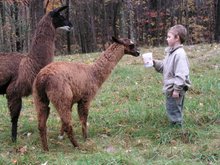
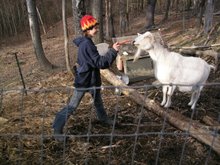
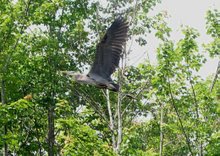
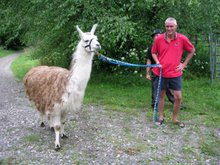
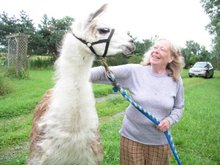
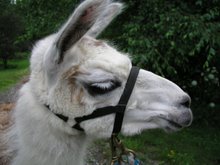




No comments:
Post a Comment